|
BULB LOG 09 --- 28th February 2007
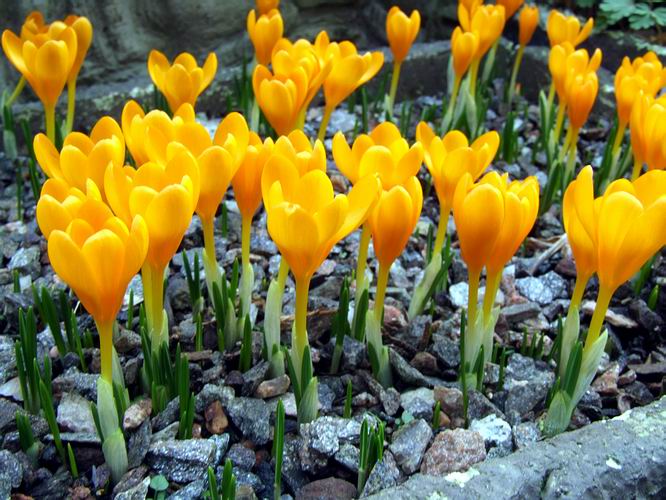
Crocus gargaricus
I am greatly amused with the talk in the press of how early all the bulbs are this year. Since starting the bulb log in January 2003 I have a very accurate photographic record of not only exactly when my bulbs came into flower but also what stage they were at week by week. Over that time there has been remarkably little variation of when the bulbs have flowered and this box of Crocus gargaricus is, in fact, a week later than normal. That leads me to another question everyone, myself included, keeps saying this is not a normal season, what exactly is a normal season? We can work out a mean or an average season but there is no such thing as a normal year.

Eranthis 'Guinea Gold'
For the last three years I have taken the box of Crocus gargaricus and this one of Eranthis 'Guinea Gold' to the Early Bulb Day in Dunblane (which is always the 3rd Saturday in February) but this year neither was ready in time. The picture above shows it the week after the Bulb Day.
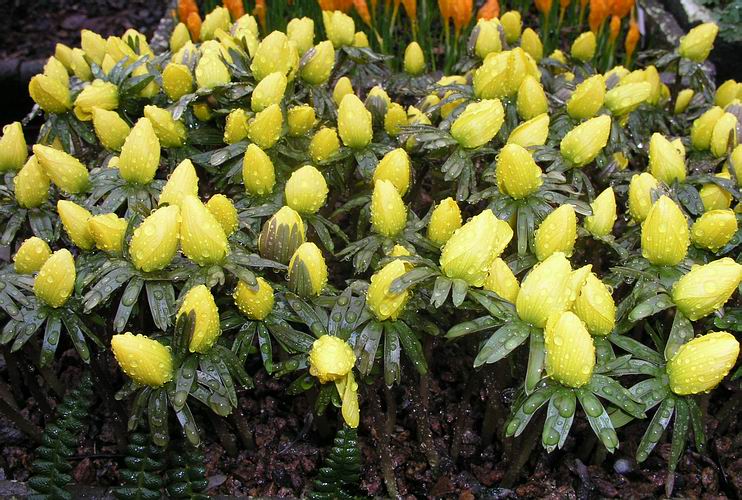
Eranthis 'Guinea Gold' in rain
Here it is photographed today, Tuesday 27 February, in the freezing rain: if only we could get a bit of warmth and some sunshine to open the flowers - the forecast is for snow!!
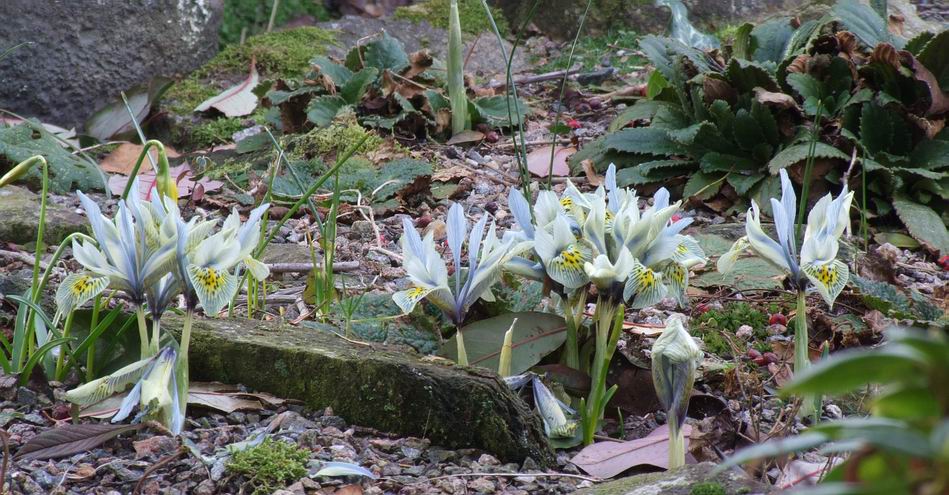
Iris 'Katharine Hodgkin'
All over the garden Iris 'Katharine Hodgkin' is flowering as always, coping well with the worst that the weather can bring. In a few beds there are fewer flowers than normal, (oops, I should say, usual,) so I will have to pay particular attention to giving them a boost of potassium and make sure that it is watered in so it goes down to the bulbs to feed them up for next year.

Galanthus 'Atkinsii group'
A fine clump of snowdrops of the Galanthus 'Atkinsii group', I have noticed that many galanthophiles are now using the term 'group' after a cultivar name - are they coming to their senses and realising that many are too similar to tell apart? This is a fine large upstanding snowdrop that forms good clumps and this one is needing split this year before the competition for nutrients between the bulbs becomes too intense and they stop flowering so well. I do not believe that shifting them in the green is the best time to lift bulbs. How can it be good for bulbs to be lifted and pulled apart from each other damaging the roots that they need to build up a reserve to flower next year? The best time to lift and split most bulbs is when they go dormant, however it is also essential that they are not kept out of the soil for any length of time, as they resent drying out and this is especially true of galanthus. On the other hand it is better to lift and split them while we remember, than it is to leave them to get eve
n more congested for another year. The old saying 'out of sight is out of mind' is very relevant and so I will lift them as the leaves yellow and start to go back before I forget them and while I can use the fading leaves to easily locate the bulbs. I think this lifting in the green came about because many of the first snow drop suppliers were old estates where the bulbs had naturalised, mostly in woodlands, for hundreds of years and the only way they could locate the bulbs was when they were in full growth. The estates employed a system of lifting a big clump placing some of the bulbs back in to the ground and selling off the surplus 'in the green'. I would hasten to say that I am not recommending that it is best to buy the dried galanthus bulbs that are offered in garden centres from about August onwards because they will have been lifted and stored dry out of the ground for months and they do not like that. It is best to buy pot grown bulbs so you see what you are getting or dried bulbs from a specialist
nursery that will lift and send the bulbs out immediately so they are not out of the ground for more than a few days.
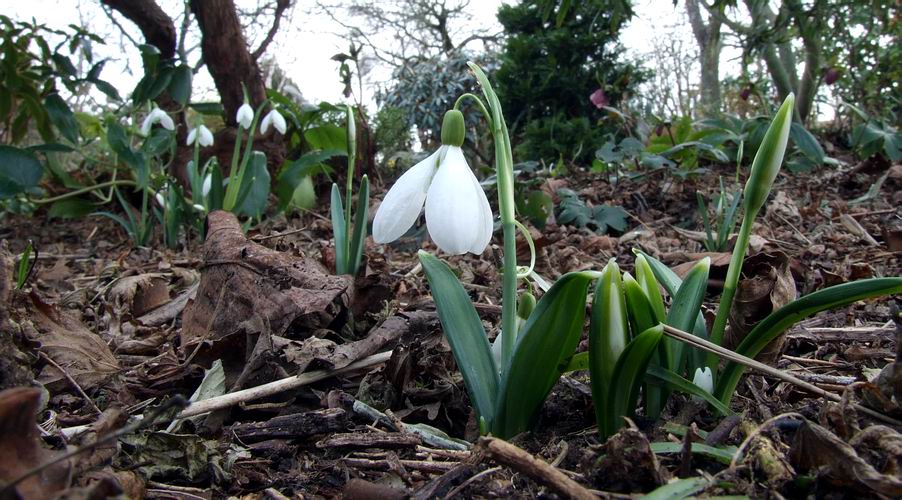
Galanthus in garden
Here is a very nice plicatus type snowdrop that is starting to increase well for us. I have never said that I do not like snow drops, I like most bulbs, and snowdrops are dear to all of us for their early display; it is the madness of the galanthophiles that amuses me as they continue to add to the list of named forms which I think already exceeds the recognisably different forms - but we must all be allowed to have our fun:-)

Galanthus Mighty Atom group
Yes I also admit to growing some galanthus in the bulb house which is especially suited for the Galanthus Mighty Atom group whose flowers are so large that they struggle to hold them up clear of the ground. In the garden their flowers touch the ground and when it is wet they get covered in mud.
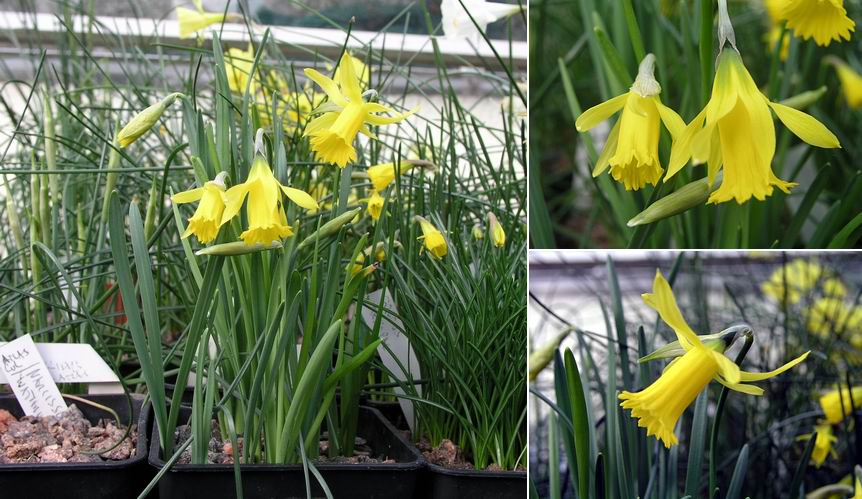
Narcissus perez-chiscanoi x cyclamineus
Now then, having had another go at all you galanthophiles I will put on my Narcissus-nurd cap and show you a few narcissus hybrids I have made as they are currently in flower. This is a pot of seedlings most of which are flowering for the first time, the seed parent was Narcissus perez-chiscanoi and the pollen parent N.cyclamineus.
Sometimes it is not clear if your crossing has been successful as the off spring can look very similar to the parents and in this group one is definitely a cross, bottom right, while it is not so easy to see the influence of the pollen parent in the others.

Narcissus perez-chiscanoi
To remind you of the seed parent here is a picture from last year as it is not in flower quite yet. I have been trying to find out more about this narcissus for many a year and thanks to John Blanchard and Brian Duncan I have gleaned some more information. The Botanist Fernández Casas now treats perez chiscanoi (and bujei) as being synonymous with N. hispanicus, but that is his opinion, not all botanists agree with him. The plant comes only from the Sierra de Saceruela near Puebla de Don Rodrigo, Province of Ciudad Real where a wide variation can be seen within a single population making it very difficult to classify them. To quote John Blanchard 'The yellow trumpets of Spain (and Portugal) are a nightmare. I know of no key which helps. When you see them in the wild the differences between them are small - and of course there are quite wide variations within single populations - and when you grow them at home they are even more difficult to distinguish. For example, one problem is that the pedicels seem to le
ngthen quite substantially between opening and fading. I suspect that we have more names than distinct species." If an expert like John has difficulty what chance is there for the rest of us? John's excellent book 'Narcissus, A Guide to Wild Species'* is constantly at my side every year when the narcissus are in flower as I try and sort out what I am growing. ( * ISBN 0900048530)
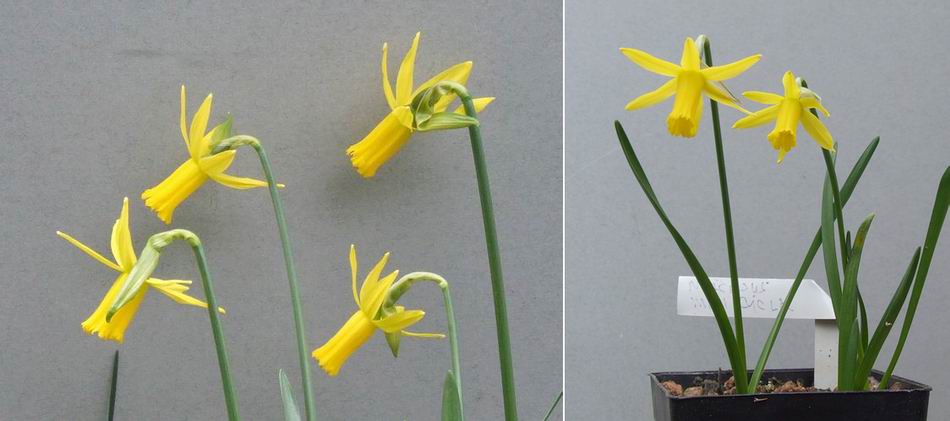
Cyclamineus x minicycla and minicycla
On the left is a hybrid I made some years ago crossing N. Minicycla, itself a hybrid between cyclamineus and asturiensis, back onto N. cyclamineus. My reason for making this cross is that I do not find Minicycla very robust and I have nearly lost it several times I have never managed to increase it beyond about 6 bulbs. My hybrid is proving much more vigorous and is increasing slowly it may just be that it is a young bulb recently raised from seed as opposed to Minicycla which has been around for a very long time.
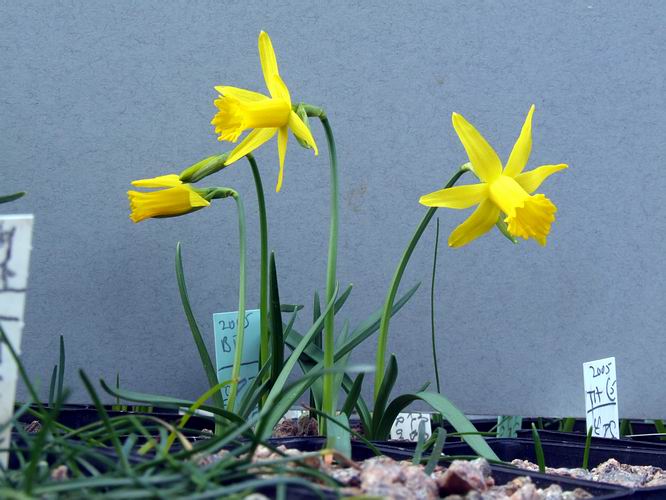
Narcissus asturiensis ex Picos de Europa
The other parent involved is the tiny Narcissus asturiensis; this form is from the famous Picos de Europa mountains that I watch the Cyclists of Le Tour De France tackle most years at an alarming fast and impressive pace. I have been collecting as many forms of asturiensis as I can in recent years as I just think it is one of the finest of the yellow trumpet daffodils I will show you more of them in the next few bulb logs.

Amana edulis
This pretty little bulb has been in and out of the genus Tulipa several times as the botanists change their minds and gather more information on it. It would seem from recent DNA studies that Amana should be retained as a good genus and not treated as a section of tulipa. Amana differs from tulipa in that there are leaf like bracts on the stem below the flower, they also grow much further east in China and Japan. It is not only for its charm as a flower that I am interested in Amana edulis but, along with Tulipa it is very closely related to Erythronium and probably diverged slightly before, or at around the same time, from the Liliaceae family tree.
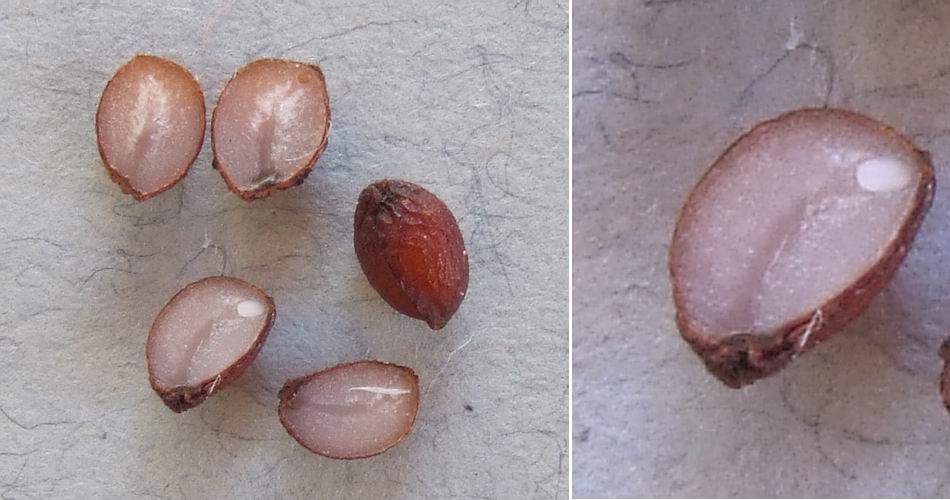
Erythronium seeds
As part of my ongoing study into Erythroniums I have been dissecting seeds and thought you would be interested to see the inside of these seeds where you can see the tiny ovate embryo (bottom left and enlarged on the right) surrounded by the food reserve of starch which will fuel the initial stage of a root and leaf growth until the plant can absorb sustenance from the soil it is growing in. The lower right seed has a miniature leaf shape form and I am not sure if this is the embryo starting to extend or if it is a malformed embryo which will not germinate despite the seed looking healthy and normal from the outside.
^ back to the top ^
|

